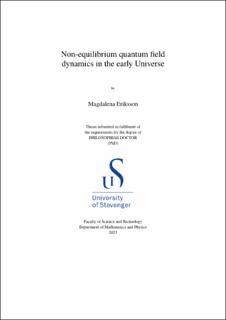| dc.contributor.advisor | Tranberg, Anders | |
| dc.contributor.advisor | Andersen, Jens O. | |
| dc.contributor.author | Eriksson, Magdalena | |
| dc.date.accessioned | 2023-08-18T13:12:06Z | |
| dc.date.available | 2023-08-18T13:12:06Z | |
| dc.date.issued | 2023 | |
| dc.identifier.citation | Non-equilibrium quantum field dynamics in the early Universe by Magdalena Eriksson, Stavanger : University of Stavanger, 2023 (PhD thesis UiS, no. 707) | en_US |
| dc.identifier.isbn | 978-82-8439-174-8 | |
| dc.identifier.issn | 1890-1387 | |
| dc.identifier.uri | https://hdl.handle.net/11250/3084853 | |
| dc.description.abstract | Inflation is the leading paradigm of early Universe cosmology. It provides compelling explanations of the observed near-homogeneity of the cosmic microwave background (CMB) radiation, the spatial flatness of the Universe and the generation of primordial density perturbations. The observed properties of the CMB, such as its isotropy, Gaussian distribution and specific temperature fluctuations, are in remarkable agreement with the predictions of inflationary models. The anisotropies in the CMB can be explained by vacuum fluctuations of light quantum fields during inflation. The spacetime expansion leads to an amplification of these quantum field fluctuations which seed classical matter density perturbations. The imprints of these perturbations are observed in the CMB and give rise to the formation of the large-scale distribution of matter in the Universe at later times.
The study of quantum fields on expanding spacetimes is a way of exploring the fundamental principles underlying inflationary cosmology. The inclusion of quantum effects modify the quantitative predictions of classical inflationary models, and investigating these corrections contributes to verifying the internal consistency and validity of various inflationary scenarios. Inflation sets the initial conditions for reheating [1, 2] and the subsequent cosmic evolution. The effective inflationary dynamics also influence symmetry-breaking processes during and after the inflationary phase. Future precision measurements of the CMB may in addition have the potential to reveal new physics beyond the Standard Model, which could be indicated by quantum corrections in inflationary models. The effect of quantum corrections on the inflationary evolution is one of the topics of investigation considered in this thesis.
The inflationary amplification of quantum modes give rise to nonperturbative phenomena. This is indicated for instance by the appearance of infrared and time-dependent (secular) divergences in quantum loop corrections to inflationary field dynamics. Secular divergences are general artefacts of usual perturbation theory applied to non-stationary, or non-equilibrium, quantum field theory. This is due to time-translation non-invariance and the general lack of an obvious (small) expansion parameter in evolving systems, which apart from secular divergences also result in pinch singularities in certain correlation functions [3, 4]. As a consequence, in the sense of resumming perturbation theory, nonequilibrium processes are inherently non-perturbative.
A comprehensive understanding of non-equilibrium phenomena therefore necessitates the use of non-perturbative methods. Examples of such methods include resummation schemes based on Schwinger-Dyson equations [5–9], the large-𝑁 expansion [10] and non-perturbative renormalisation group techniques [11–17]. A more first-principles non-perturbative approach is lattice field theory. In thermal (equilibrium) field theory, non-perturbative physics can be captured by means of numerical Monte-Carlo integration of the path integral on a discretised Euclidean spacetime lattice. However, in the presence of a chemical potential or out of thermal equilibrium, the emergence of the sign problem [18] hinders the use of this approach. In the regime of large particle numbers, quantum dynamics can be approximated by its corresponding classical evolution equations. Classical-statistical simulations can accurately capture non-perturbative effects when statistical fluctuations dominate over quantum fluctuations. However, the presence of Reyleigh-Jeans divergences at high momenta restrict the momentum range applicable to the classical-statistical approximation. For this reason it should be viewed as an effective theory for highly-occupied, low-momentum modes.
[...] | en_US |
| dc.language.iso | eng | en_US |
| dc.publisher | University of Stavanger, Norway | en_US |
| dc.relation.ispartofseries | PhD thesis UiS; | |
| dc.relation.ispartofseries | ;707 | |
| dc.rights | Navngivelse 4.0 Internasjonal | * |
| dc.rights.uri | http://creativecommons.org/licenses/by/4.0/deed.no | * |
| dc.subject | fysikk | en_US |
| dc.subject | kosmologi | en_US |
| dc.title | Non-equilibrium quantum field dynamics in the early Universe | en_US |
| dc.type | Doctoral thesis | en_US |
| dc.rights.holder | ©2023 Magdalena Eriksson | en_US |
| dc.subject.nsi | VDP::Matematikk og Naturvitenskap: 400::Fysikk: 430 | en_US |

